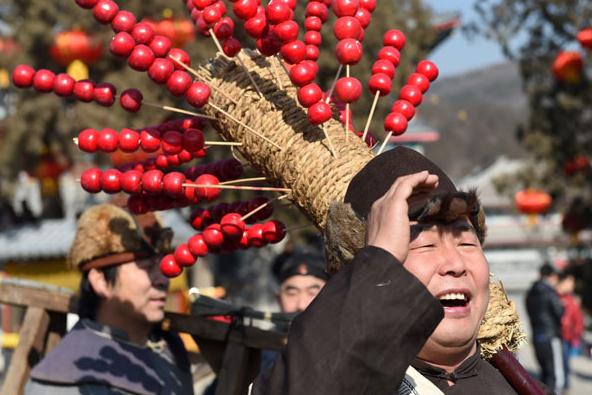
A performer practices crying out his wares as a street vendor at Badachu Park on Feb 9. (Source: China Daily/ Li Jundong)
Despite more and more young people turning their back on tradition, temple fairs remain a favorite event during Spring Festival.
Zhu Changdui, who works for the Postal Savings Bank of China and comes from Ankang, Shannxi province, said he remembers reading about Spring Festival in Beijing when he was young. He recalls reading of children with red cotton-padded jackets running out the hutong to join the temple fairs and see dragons dancing, martial arts performances and people selling traditional snacks.
"In recent years, Spring Festival has not been like the ones when I was little because of the rapid change in society, especially in my hometown," said the 28-year-old, who added that his relatives like to celebrate the festival by playing mahjong.
"However, I think Beijing has preserved a lot of the old tradition and blended it with the new trends."
This year will be the first time Zhu has stayed in Beijing during Spring Festival since he settled in the capital four years ago. He said he would like to capture as much of the traditional spirit as possible.
"I plan to visit temple fairs and I have a schedule for them. I think my camera will not have a few days off then," Zhu joked.
Temple fairs, or miaohui, are said to hail back to ancient days, when farmers would offer new year sacrifices to their village gods. The events developed into marketplaces for goods and ideas, where people would peddle their wares and performers would put on shows.
Temple fairs grew in prominence throughout the Ming and Qing dynasties (1368-1911), but essentially evaporated with the founding of New China in 1949, and they were taboo during the "cultural revolution" (1966-76).
The country's first official temple fair after 1949 was in 1985 at Beijing's Temple of the Earth (Ditan Park). Now they are once again an important part of the Spring Festival and they continue to evolve.
The carnivals in parks such as Ditan, Tiantan and others with a long history largely remain true to tradition, and they evoke imperial times and folk memories.





